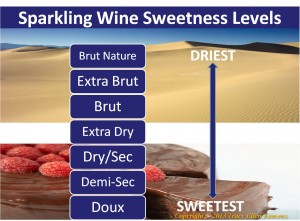Those who know me well, know that I love everything that sparkles – wine, water, personalities and diamonds. With Christmas and New Year’s Eve lurking around the corner, it is the perfect time to break out the bubby, whether it’s a special bottle of vintage Champagne*, a fresh and fruity Prosecco or a fabulously food-friendly Lambrusco. As long as it glitters, all is right in the world J
Of course, sparkling wines should be welcome guests at the table any time of year, but with holiday festivities and parties proliferating your social schedule, there is even more reason to celebrate with CO2 infused libations.
For the uninitiated, the world of sparkling wine can be quite complicated with terms appearing on these labels not seen on other wines such as blanc de blancs. Plus, if you’ve tried to use the literal translation of those sweetness levels, you’ve likely been a bit disappointed or at least quite confused.
Looking for an easy way to teach yourself or others to remember the basics of sparkling wine?
As an educator, I prefer to appeal to people’s visual learning style because it can be much more powerful than simple text. There’s a reason the adage “A picture is worth a thousand words” has become so popular. Equally important, images can highlight familiar concepts or reinforce associated meaning when introducing new concepts. To that end, I’ve created two infographics, which you may find helpful to you as you shop for wine or engage your students this holiday season (click on the thumbnails for larger version images).
I’ve also found another nifty visual aid over at Wine Folly.
For more tips on sparkling wine, check out the holiday issue of my newly launched magazine – Drink Wisely & Well (and also see the inaugural issue, which featured Bordeaux). I’m really proud of this new publication and have gotten a lot of praise on the design (and not just from my parents).
As for why Extra Dry is a misnomer, I really can’t say; even Jancis Robinson’s Oxford Companion to Wine (3rd edition) didn’t have an answer. But, whether your preference is for dry, sweet or somewhere in between, I raise a flute to you and wish you all the best as we count down 2013 and usher in 2014!
*It’s admittedly a pet peeve of mine, but in case you didn’t know, the term Champagne is NOT generic; it should be reserved specifically for those sparkling wines produced in the Champagne region of France.


